Carolin Haug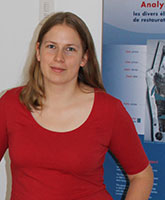 Department of Cytology and Evolutionary Biology
Department of Cytology and Evolutionary Biology
Zoological Institute and Museum
University of Greifswald
Soldmannstrasse 23
17487 Greifswald
Germany
Carolin Haug studied biology at the Julius-Maximilians-Universität Würzburg with animal ecology as major subject and sociobiology and palaeontology as minor subjects. She received her Diplom in 2005 and moved to the University of Ulm for her PhD thesis. In the work group Biosystematic Documentation she investigated the ontogeny and evolution of the arthropod head shield on a wide spectrum of fossil and extant specimens. Due to the very different demands of the material, she developed new imaging techniques or modified existing methods together with her collaborators, for example, composite imaging, stereo photography or autofluorescence macro- and microscopy. In 2011, Carolin defended her PhD thesis. She was a postdoctoral researcher at Yale University and is currently at the Ernst-Moritz-Arndt-Universität Greifswald. Besides optimising imaging techniques, she is interested in fossilised development (see also http://www.palaeo-evo-devo.info) and in the evolution of tagmosis. For this purpose, she investigates mainly arthropods from different deposits yielding exceptional preservation, such as Rhynie chert, Solnhofen Lithographic Limestones, the 'Orsten', Burgess Shale, or Mazon Creek, always in comparison to their extant relatives. Carolin will move to Munich in September 2013 to continue her research there at the Ludwig-Maximilians-Universität.
![]()
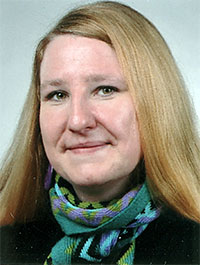
Verena Kutschera
Biosystematic Documentation
University of Ulm
Helmholtzstrasse 20
89081 Ulm
Germany
Verena Kutschera studied biology and philosophy at the University of Ulm. She finished her diploma in 2009 in the Biosystematic Documentation at the University of Ulm where she is working on her PhD now. Ever since, Verena was interested in the phylogeny of Crustacea, especially the Malacostraca. For contributing to this interesting topic, she became an expert in morphology: she is an exquisite drawer, very experienced in many kinds of microscopical techniques (fluorescence microscopy, transmitted light microscopy, scanning electron microscopy, all combined with composite imaging), and three-dimensional reconstruction taking also advantage of stereoscopic effects. Thematically, Verena focuses on the hindbody of malacostracan Crustacea, the pleon, in her dissertation. She studies the pleon morphologically to reveal the phylogenetic significance of the hindbody, which has been neglected for phylogenetic considerations so far.
![]()
Shane T. Ahyong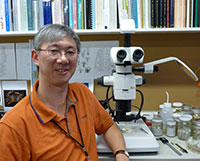 Australian Museum
Australian Museum
6 College Street
Sydney, NSW 2010
Australia
Shane Ahyong is a Senior Research Scientist and Manager of Marine Invertebrates at the Australian Museum, Sydney. He received his Ph.D from the University of New South Wales in 2000, and held posts at the Sydney University and the Australian Museum, prior to joining the National Institute of Water and Atmospheric Research, New Zealand, in 2006 to head the Marine Biodiversity and Biosecurity Group, and manage the Marine Invasives Taxonomic Service. In 2010, moved his current position at the Australia Museum. Shane is a world authority on the phylogeny and systematics of stomatopod and decapod Crustacea, on which he publishes extensively, investigating all parts of the phylogenetic system. Studies span alpha-taxonomy of modern and fossil species to high level phylogenetic analyses using morphological and molecular data. Current projects include molecular phylogenetics of the stomatopod crustaceans and worldwide distributions of squat lobsters. Other research interests include phylogenetic methods and biological invasions. Together with Gary Poore and Joanne Taylor, Shane recently co-edited a major book, The Biology of Squat Lobsters (2011, CSIRO Publishing & CRC Press). Shane serves as a Subject Editor for the World Register of Marine Species (WoRMS) and in 2012, was elected President-Elect of The Crustacean Society.
![]()
Francisco J. Vega Instituto de Geología
Instituto de Geología
UNAM
Ciudad Universitaria
Coyoacán
México DF 04510
Mexico
Francisco J. Vega was born in Mexico City, 1960. He studied Biology at the Sciences School, UNAM, where he got his PhD in 1988. Full time professor at the Instituto de Geología, UNAM, since 1987.
His contributions deal with the fossil record of decapod crustaceans, mainly fom Mexico, but also has papers on fossil crustaceans from the USA, Belize, Colombia, Venezuela, Morocco, Iran and India.
He is currently interested in the fossil crustacea embedded in Miocene amber from Mexico.
Editor of three journals and past-president of the Mexican Paleontological Society.
He teaches Animal Biology at the Sciences School, UNAM.
![]()
Andreas Maas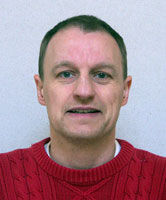 Biosystematic Documentation
Biosystematic Documentation
University of Ulm
Helmholtzstrasse 20
89081 Ulm
Germany
Andreas Maas is a research assistant at the University of Ulm. He studied biology at the Christian Albrechts University of Kiel, Germany and graduated in 1998 with a diploma thesis on the larval development of the Antarctic krill Euphausia superba. In 2002 he made his PhD in zoology at the University of Ulm. Andreas studied a Cambrian group of crustaceans, the Phosphatocopina; their systematic position within Crustacea could be established as the sister group of the crustacean crown group, the Eucrustacea. The material of his study is part of the so-called ‘Orsten’ type of preservation that leads to three-dimensional fossils of mainly less than 1 mm in size. Since 2002 Andreas is also involved in teaching at the University of Ulm and did his habilitation in 2008. He was part of a German-Chinese research cooperation and was able to work on fossils from the famous lower Cambrian Chengjiang fauna. With this Andreas consolidated his main research subject in the early evolution and phylogeny of arthropods. He could widen this subject also on the question of the phylogenetic position of arthropods within the Bilateria. Andreas worked on very early, worm-like arthropods without sclerotised dorsal tergites that were from the same Cambrian material as the phosphatocopines before. Another important Cambrian fossil he described was a minute, Cambrian, possibly immature stage of a new species of Cycloneuralia. Shergoldana australiensis gives some clues about the evolution of larval forms within Nemathelminthes. This is especially important since arthropods are regarded as close relatives of round worms nowadays. Andreas’ research techniques comprise mainly scanning electron microscopy due to the small size of the fossils. Important other skills are computer-aided imagery and computer-aided phylogeny analyses. Andreas teaches evolutionary biology including history and background of Darwin’s important work and evolution, systematics and phylogeny of animals, Metazoa.
![]()
Dieter Waloszek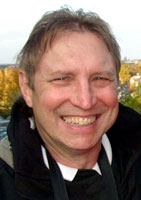 Biosystematic Documentation
Biosystematic Documentation
University of Ulm
Helmholtzstrasse 20
89081 Ulm
Germany
Dieter Waloszek is working as a professor at the University of Ulm. He studied biology in Hamburg and finished his dissertation with a thesis on a scallop from Argentinian offshore waters. In 1982 Dieter moved to the Institute of Palaeontology in Bonn to work together with Klaus J. Müller, the discoverer of the Cambrian 3d-preserved, so-called ‘Orsten’ fossils, mainly arthropods. After his habilitation in 1991 on one of the faunal elements, the crustacean Rehbachiella kinnekullensis, and the phylogeny of Branchiopoda and Crustacea and one year in Kiel, Dieter received a professorship in Ulm in 1995. Since then, he and his workgroup continue the studies of ‘Orsten’ fossils. Major method remains the SEM, but the workgroup expanded their investigations to other localities worldwide, material from extant and other fossil sources and their methodological range for improving the documentation of this important evolutionary data source.
More recent highlight: foundation of the international C.O.R.E. group of scientists with a specific interest in ‘Orsten’ studies.
Main interests: morphology, incl. functional aspects, ontogeny, phylogeny and evolution – no taxonomic restriction in general, but due to capacity problems, focus on Arthropoda. Output (incl. team work): more than 100 papers in international journals. Main hobbies: family, fistball, holidays in Sweden, incl. fishing and waterskiing.
![]()
Joachim T. Haug Department of Cytology and Evolutionary Biology
Department of Cytology and Evolutionary Biology
Zoological Institute and Museum
University of Greifswald
Soldmannstrasse 23
17487 Greifswald
Germany
Joachim T. Haug studied animal ecology (major), sociobiology and palaeontology (minors) at the Julius-Maximilians-Universität Würzburg. After the receipt of the Diplom in 2005, he moved to the work group Biosystematic Documentation at the University of Ulm for his PhD thesis. There he worked on the early crustaceans from the Cambrian 'Orsten', which are preserved three-dimensionally and with minute details. To make the entire morphology clearly visible, Joachim produced computer-based 3D models for each developmental stage of a species, resulting in a 4D model of the species. With 4D models reconstructed for the different species, differences in the developmental pattern between the species became visible. These changes in the developmental timing, so-called heterochronic events must have occurred several times during early crustacean evolution. Due to these findings, Joachim got interested in studying such evolutionary changes of development also in fossils from other deposits and focussed on Palaeo-Evo-Devo (see also http://www.palaeo-evo-devo.info). After his defense in 2009 and two further years as postdoctoral researcher in Ulm, he received two Feodor Lynen research fellowships from the Alexander von Humboldt-Foundation, with which he was doing research at Yale University and at the Ernst-Moritz-Arndt-Universität Greifswald. Besides 3D modelling, Joachim is also interested in different methods of imaging (documentation and presentation). In September 2013, he will relocate to the Ludwig-Maximilians-Universität in Munich.
![]()

